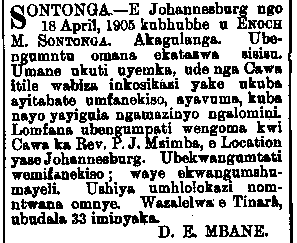The origins of Enoch Sontonga and the song he wrote, Nkosi Sikelel' iAfrika are humble and rather obscure.
Enoch Sontonga, from the Mpinga clan, of the Xhosa nation, was born in the Eastern Cape in about 1873. It is believed that he received training as a teacher at Lovedale Institution and was then sent to a Methodist Mission school in Nancefield, near Johannnesburg. He was also a choirmaster and a photographer. He married Diana Mgqibisa, the daughter of a prominent minister in the African Methodist Episcopal Church. She died in 1929, in Johannesburg.
Sontonga died at the age of 32. The sources differ about the year of his death, ranging from 1897 to 1904. It has since been established that he died on 18 April 1905.
Enoch Mankayi Sontonga wrote the first verse and chorus and also composed the music in 1897. It was first sung in public in 1899 at the ordination of Rev Boweni, a Shangaan Methodist Minister.
Sontonga's choir as well as other choirs sang this song around Johannesburg and Natal. This song made a strong impression on all audiences. On 8 January 1912, at the first meeting of the South African Native National Congress (SANNC), the forerunner of the African National Congress, it was immediately sung after the closing prayer. In 1925 the ANC officially adopted it as a closing anthem for its meetings.
The song spread beyond the borders of South Africa and has been translated and adapted into a number of other languages. It is still the national anthem of Tanzania and Zambia and has also been sung in Zimbabwe, Namibia and South Africa for many years. In 1994 it became part of South Africa's national anthem.
Nkosi Sikekel' was first recorded on 16 October 1923 by Solomon T. Plaatje accompanied by Sylvia Colenso on the piano. A well known Xhosa poet, S.E.K. Mqhayi, wrote a further seven verses. In 1927 the Lovedale Press, in the Eastern Cape, published all the verses in a pamphlet form. It was included in the Presbyterian Xhosa hymn book, Ingwade Yama-culo Ase-rabe in 1929.
It was also published in a newspaper, Umtetela Wa Bantu on 11 June 1927 and in a Xhosa poetry book for schools.
In 1994 the National Monuments Council became aware that Sontonga was possibly buried in the historical Braamfontein Cemetery in Johannesburg.
The purpose of locating the grave was to have it declared as a national monument, which is the highest honour that can be bestowed on a site of such historical and cultural significance.
Over the years, several unsuccessful attempts had been made to locate Sontonga's grave in Braamfontein cemetery. However, it was not until Hal Shaper of Cape Town prompted the cemetery officials to look for an entry in the burial register under Enoch, rather than Sontonga, and to look at burial records for 1905, that success was achieved.
The register at Braamfontein lists the date of burial as 19 April 1905 in Plot No 4885. Confirmation that this is indeed the grave of Enoch Sontonga was subsequently found in a notice in the newspaper, Imvo Zabanstundu2,, which stated that Enoch Sontonga had died unexpectedly on 18 April 1905 in Johannesburg. The newspaper report also noted that he was born in Uitenhage in the Eastern Cape and that he had one son.
To establish exactly where Plot No 4885 was, became a major undertaking. The search was complicated by the fact that during the early 1960s that particular section of the cemetery, comprising 10 acres, was levelled and landscaped. Mr Alan Buff, Regional Manager (Parks and Cemeteries) of the GJTMC, did detailed research on the existing records that took over a year to complete. He studied the site plan for a proposed park in 1960, the burial concept plan of 1898, an area site plan of 1909, infra-red burial plan of 1969 and the aerial photograph of 1938 and merged all the information gathered to identify the area in which the grave was located.
Identification of the grave itself was part of a second stage in which Professor Tom Huffman of the Department of Archaeology at the University of the Witwatersrand was contracted to do a shallow archaeological excavation to confirm the burial spacing. Finally, from the interpolation of all the data, a site plan was drawn identifying the plot considered to be the grave of Enoch Sontonga.
On 24 September 1996, Heritage Day, the grave of Enoch Sontonga, who wrote the song that has over the years brought comfort and joy to millions of people, was declared a national monument and a fitting memorial, erected on the site, was unveiled by President Nelson Mandela.
At the ceremony the Order of Meritorious Service (Gold) was bestowed on Enoch Sontonga posthumously. His granddaughter, Mrs Ida Rabotape received it.
The programme included praise poetry and a narration that told something of this man, who wrote a song almost 100 years ago that, unbeknown to him, became one of peace and healing for the Rainbow Nation of South Africa.
Geneveve Walker
National Monuments Council
1996
 Original Xhosa item in the newspaper Imvo Zabantsundu.
Original Xhosa item in the newspaper Imvo Zabantsundu.
Translation of original Xhosa item in the newspaper Imvo Zabantsundu, dated 27 June 1905
SONTONGA, E. Johannesburg. On 18 April 1905 ENOCH M. SONTONGA passed away. He was not sick this time. He, however, suffered at times from stomach ache to the extent that he would predict that these were his last days on this earth. One Sunday he requested to take a photograph of his wife. The wife refused because she was suffering a toothache that particular day. This young man was a composer for the Church of Rev. P.J. Mzimba at one location in Johannesburg. He was also a photographer and a lay preacher. He is survived by his wife and one child. He was born in Uitenhage and was 33 years old.

